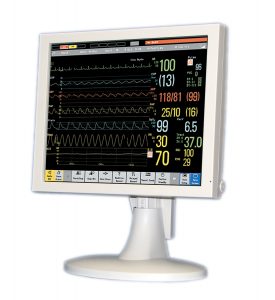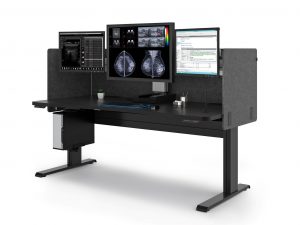Almost twenty years ago, LCD screens began to replace traditional CRT monitors in diagnostic imaging. Their thinner size, reduced energy requirements, and most importantly, flat panels that improved distortion and increased viewing angle, meant that LCD medical grade displays were quick to be adopted by radiologists.
Manufacturers worked to fix reported problems with LCD monitors, such as flickering due to reduced refresh rate. The resulting medical grade monitors available on the market today offer even greater benefits to radiologists, such as better LED screen lighting that makes viewing images more consistent. While medical grade flat panels have improved, consumer grade displays have improved in ways which appear, on the surface, to narrow the gap between the two types of screens. The 4K Ultra HD displays on the market today are extremely high resolution and can appeal to medical practices looking to save money on their monitor purchases. Are these consumer LCD monitors a viable option in the diagnostic lab?
Consumer Grade Cautions
Medical grade computer monitors are still recognized as superior to consumer grade displays for a few key reasons.
- • Life span. Medical LCD screens, made with higher-quality components, last up to four times longer than a high-resolution consumer monitor.
- • Consistency. Consumer grade monitors used for a family’s video games or an office worker’s data input don’t require consistent image quality reproduction, but that accuracy is necessary in medical applications.
- • Understanding of diagnostic requirements. Manufacturers of medical grade displays know that it’s vital for the monitors to show small details clearly, while consumer grade monitors are made to cover a variety of less-detailed uses.
- • Ability to meet medical standards for soft copy viewing. Digital Communications in Medicine publishes DICOM standards that diagnostic monitors must meet. Medical grade displays meet these requirements, while consumer displays do not.
- • Warranties. The companies that manufacture medical grade displays provide longer warranties in most cases than a consumer-focused manufacturer will.
Call for Superior Medical Monitors!
While it may be less expensive to purchase consumer grade displays, the cost savings may evaporate as they will need to be replaced more frequently and may be unused due to their inability to meet the needs of the diagnostic environment.
Physician Confidence
Medical LCDs must have the ability to show small details, display a full range of colors, as well as shades of gray, and show a consistently bright image. Consumer grade displays may not be able to meet the exacting needs of radiologists.
Many medical professionals may be uncomfortable using a consumer monitor as they could risk making an incorrect interpretation. Diagnostic accuracy is prized above all else by radiologists, and they may be unwilling to sacrifice the guaranteed performance of medical grade displays. The proven consistent images from a medically certified monitor increase doctors’ confidence in these tools that they use every day.
In addition, radiologists require multimodality flexibility in their displays to manage the wide range of images they must evaluate. A full range of colors is important for viewing PET scans, but grayscale calibration is vital for CR/DR, Mammo/Tomo, CT and MRI images. Medical displays are better able to deliver the performance for several types of images that diagnostic professionals need, especially large-format color displays with 6MP and 8MP resolution.
Medical practices must also weigh the cost savings with consumer monitors against time wasted with longer viewing times and higher false positives. Doctors may take more time to evaluate images on screens with reduced color display and resolution.
Comparing Specifications for Medical Displays Against Consumer Displays
Clear differences exist in the image quality presented by medical monitors when compared to consumer grade monitors:
- • High-end medical grade displays can show up to 1 billion colors. The best consumer monitors display 16 million colors. Most consumer uses don’t require the increased number of colors, but a trained radiologist will be able to see more detail.
- • Medical displays show a continuous luminance level from a cold start and include tools that automatically calibrate and adjust the monitor. In contrast, consumer displays may vary in luminosity and be unable to perform well immediately when powered up; they need manual calibration regularly for high performance.
- • At the same time, medical displays are engineered to maintain a uniform dispersion of light output in order to provide consistency across the entire display. Uniformity across the screen as a whole reduces the number of errors which could occur during a study due to an incorrectly “lit” or “dim” portion of the display. Non-medical displays may show a high amount of “light leakage” or inconsistency in light output across the screen as a whole, and appear “splotchy”. A non-medical display with the brightness turned up quite high would also be likely to wash out black and darker gray levels with said light leakage.
- • Reliability and longevity are much better with a medical grade display. Life spans are typically four times longer in a medical display because of its use of higher-quality components.
- • Medical displays also have built in backlight stabilization and monitoring. Our eyes don’t notice as a display slowly degrades over time or loses brightness. The brightest a commercial grade display will ever be is right out of the box, and often it doesn’t meet its peak luminance even then. Backlight stabilization built into medical grade displays ensures that the brightness level stays consistent over time and from monitor to monitor.
Medical displays also are certified to meet DICOM standards for luminosity and contrast. This means that certified medical grade monitors meet or exceed specifications for providing accurate and detailed images that can be easily read under the varied lighting conditions in a diagnostic setting.
Do Consumer Displays Have a Place in the Diagnostic Lab?
While the gap is closing between image quality of medical grade and consumer grade displays, there are still many issues with the use of a monitor that doesn’t meet medical standards in a diagnostic environment.
Physicians and radiologists are likely to find that consumer displays do not deliver the consistency and accuracy required to make complete patient diagnoses. Time is wasted viewing and analyzing less-detailed images, but even more importantly, patients could receive incomplete or inaccurate information about their health.
Buyers for a medical group, charged with saving money whenever possible, may find the lure of less expensive consumer monitors appealing. However, consumer monitors may need to be replaced as many as four times more often than medical grade displays, negating any initial cost savings.
From the perspectives of doctors, radiologists, accountants, and patients, medical grade displays offer higher quality, longer life, and better ease of use that consumer monitors simply can’t beat. Eventually, consumer displays may find a place in the diagnostic lab, but for now, medical displays are still the best option available on the market.
Double Black Imaging makes the most efficient and technologically advanced medical display systems available, ensuring that diagnostic professionals have reliable and long-lasting tools for the work they do every day. For current information about quality medical grade displays, the use of automated calibration tools and other benefits of purchasing monitors from Double Black Imaging, please contact our diagnostic imaging experts. We can answer your questions, offer demos, and show you how our monitors outshine the competition.
References
consumer-grade-vs-medical-grade-displays
consumer-grade-vs-medical-grade-displays
s00330-017-4923-8












